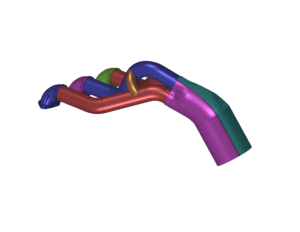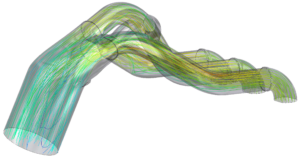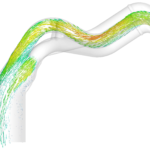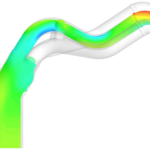May 21-25, 2018
Palazzo Vistarino, Pavia
The NL18 course has a very high scientific profile due to the expertise of the professors and to the discussed topics, ranging from classical basics to the most advanced state-of-the-art of linear and nonlinear computational mechanics.
Moreover, the course has a strong international character in terms of teaching body, including renown experts from the University of California at Berkeley and the University of Stuttgart, along with professors from academic institutions in Pavia.

Fig. 1 Exhaust manifold for motorcycle industry

Fig. 2 Velocity streamlines for the flow inside the manifold

Fig. 3 Velocity vectors for the flow inside the manifold

Fig. 4 Exhaust gas pressure contours for the flow inside the manifold
Course Objectives
The main objective of the course is to provide engineers who use computer codes, graduate students, and researchers with a review of numerical techniques and solution algorithms for nonlinear mechanics. The course indeed introduces the current state-of-the-art in finite element modeling of nonlinear problems in solid and structural mechanics and illustrates issues (and possible solutions) that could appear in a number of applications.
The course reviews systematically different sources of nonlinear behavior, paying special attention to nonlinear constitutive behavior of materials, large deformations and rotations of structures, contact and instability problems with either material (localization) or geometric (buckling) nonlinearities, which are needed to fully grasp weaknesses of structural design.
The course will also provide insight both on advanced mathematical aspects and on the practical aspects of several computational techniques, such as the finite element method, isogeometric analysis, meshless techniques and virtual element methods.
Objective of the course is thus to provide the participants with a solid basis for using computational tools and software to achieve the optimal design, and/or to carry out a refined analysis of nonlinear behavior of structures.
The course finally provides a basis to account for multi-physics and multi-scale effects, likely to achieve a significant break-through in many industrial applications.
Tutorials and Course Material
Special emphasis will be given to FEAP personal version (projects.ce.berkeley.edu/feap/feappv/) or simple “in house” codes written in Matlab or Maple.Copies of Finite Element Analysis Program (FEAPpv) computer codes, by Prof. Robert L. Taylor at UC Berkeley, and the complete volume of notes will be available to all attendees together with electronic copies of other lecture materials and survey papers.

